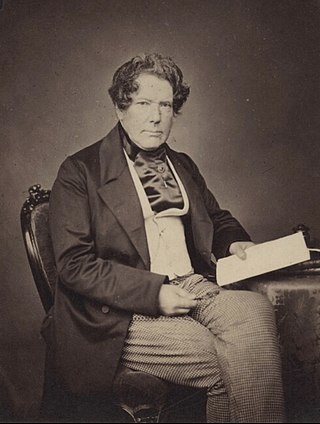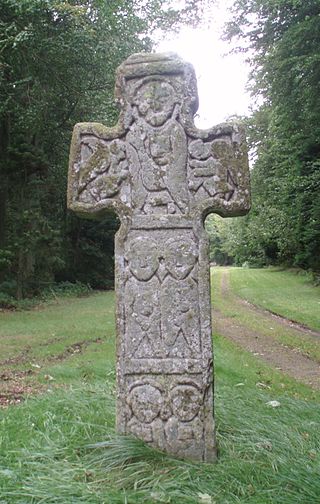Related Research Articles

Earl of Dalhousie, in the County of Midlothian, is a title in the Peerage of Scotland, held by the Chief of Clan Ramsay.

Earl of Panmure was a title in the Peerage of Scotland. It was created in 1646 for Sir Patrick Maule, a former Gentleman of the Bedchamber to James VI and loyal follower of Charles I. He was made Lord Brechin and Navar at the same time, also in the Peerage of Scotland. Both titles were forfeit by the attainder of the 4th Earl in 1716 on account of his participation in the Jacobite rising of 1715. The heirs apparent to the Earldom were styled Lord Maule. The seat of the Earldom was Panmure House, built in the 17th century near Monikie, Angus.

Fox Maule-Ramsay, 11th Earl of Dalhousie,, known as Fox Maule before 1852, as The Lord Panmure between 1852 and 1860, was a British politician.

William Ramsay Maule, 1st Baron Panmure of Brechin and Navar was a Scottish landowner and politician.
William Maule may refer to:

The Camus Cross, otherwise known as the Camuston or Camustane Cross, is an Early Medieval Scottish standing stone on the Panmure Estate near Carnoustie in Angus, Scotland. First recorded in the 15th century in a legal document describing the boundaries between Camuston and the barony of Downie, and described in the 17th century by Robert Maule, it is a freestanding cross, rare in Eastern Scotland.
Philip de Valognes, Lord of Ringwood, Benvie and Panmure was an Anglo-Norman Scottish noble. He was the Lord Chamberlain of Scotland between 1165–1171 and 1193–1214.

William de Valognes also known as William de Valoynes, was the only son of Philip de Valognes and was granted a charter of the baronies of Panmure and Benvie by King William the Lion, previously granted to his father. On his father's death in 1215, William de Valongnes was made High Chamberlain to Alexander II. He died in 1219 and was interred at Melrose Abbey.
Sir Peter Maule was the eldest son of Richard Maule of Fowlis. He married Christina de Valognes, daughter and heiress of William de Valognes around 1224, passing the baronies of Panmure and Benvie into the Maule family.
Thomas Maule may refer to:
Sir Thomas Maule was the youngest son of Sir Peter Maule and Christina de Valognes, Baron and Baroness of Panmure and Benvie.
William Maule (fl.1348-) was the eldest son of Sir Walter Maule, Baron of Panmure and Benvie. William succeeded as Baron in 1348 on his father's death. He married Marion Fleming of Biggar, daughter of Lady Jane Barclay of Brechin. He died before 1407 and left one son, Thomas Maule, who succeeded him as Baron, and one daughter, Janet Maule, who married Alexander Ochterlony of Kenny.
Sir Henry Maule was the son and heir of Sir William Maule, Baron of Panmure and Benvie and Ethana de Vallibus, daughter of John Vaux, Lord of Dirleton. Henry succeeded as Baron on his father's death and was married to Margaret Hay, daughter of Sir William Hay of Locherworth.
Walter Maule was the son and heir of Sir Henry Maule, Baron of Panmure and Benvie, and Margaret, daughter of Sir William Hay of Locherworth. He was warden of Kildrummy Castle in the reign of David II.
Panmure Castle was a castle that was located to the north-west of Muirdrum, Angus, Scotland.
Sir William Maule was the eldest son of Sir Peter Maule and Christina de Valognes, Baron and Baroness of Panmure and Benvie. William succeeded as Baron in 1254 on his father's death. He was married to Ethana de Vallibus, daughter of John Vaux, Lord of Dirleton, and left one son, Henry Maule, who succeeded him as Baron.
Thomas Maule, 3rd Baron of Panmure and Benvie, was the eldest son of Sir Thomas Maule, Baron of Panmure and Benvie, who was killed at the Battle of Harlaw in 1411 and Elizabeth Gray of Fowlis. Thomas succeeded as Baron on his father's death while still a child, and his affairs were administered by his grandfather, Sir Andrew Gray of Fowlis, until he came of age.
Thomas Maule, 2nd Baron of Panmure and Benvie, was the eldest son of Sir William Maule, Baron of Panmure and Benvie and Marion Fleming. Thomas succeeded as Baron on his father's death before 1407. He was killed on 24 July 1411 at the Battle of Harlaw, fighting under Alexander Stewart, Earl of Mar. He is mentioned in the Child ballad, The Battle of Harlaw:

Sir Henry de Baliol of Cavers was Chamberlain of Scotland.
Maule is a surname. Notable people with the surname include:
References
- 1 2 Maule, Harry (1874), Stuart, John (ed.), Registrum de Panmure. Records of the families of Maule, De Valoniis, Brechin, and Brechin-Barclay, united in the line of the Barons and Earls of Panmure, Edinburgh: Fox Maule-Ramsay
- ↑ Royal Historical Society (1986), Handbook of British Chronology, Cambridge University Press, pp. 184–185, retrieved 27 October 2010